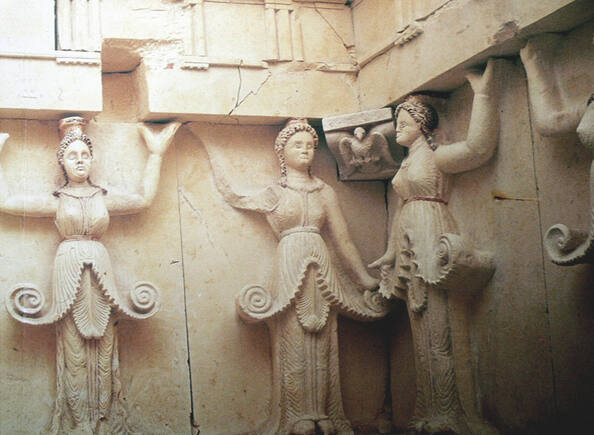斯韦什塔里的色雷斯人墓
Thracian Tomb of Sveshtari
Discovered in 1982 near the village of Sveshtari, this 3rd-century BC Thracian tomb reflects the fundamental structural principles of Thracian cult buildings. The tomb has a unique architectural decor, with polychrome half-human, half-plant caryatids and painted murals. The 10 female figures carved in high relief on the walls of the central chamber and the decoration of the lunette in its vault are the only examples of this type found so far in the Thracian lands. It is a remarkable reminder of the culture of the Getes, a Thracian people who were in contact with the Hellenistic and Hyperborean worlds, according to ancient geographers.
Description is available under license CC-BY-SA IGO 3.0
Tombeau thrace de Svechtari
Découvert en 1982, près du village de Svechtari, ce tombeau thrace du IIIe siècle av. J.-C. illustre les principes fondamentaux de construction des bâtiments religieux thraces. Le tombeau présente un décor architectural unique avec ses cariatides polychromes mi-humaines mi-végétales et ses peintures murales. Les dix silhouettes féminines réalisées en haut-relief sur les murs de la chambre centrale et le dessin graphique de la lunette de sa voûte sont les seules décorations de ce type découvertes jusqu’ici sur le territoire thrace. C’est un témoignage remarquable sur la culture des Gètes, population thrace qui fut au contact des mondes hellénistique et hyperboréen, selon les termes de la géographie antique.
Description is available under license CC-BY-SA IGO 3.0
الضريح التراقي في سفيشتاري
اكتُشف هذا الضريح التراقي الذي يرقى إلى القرن الثالث قبل الميلاد في العام 1982 بالقرب من بلدة سفيشتاري، وهو يعكس المبادئ الأساسية لتشييد النصب الدينية التراقية. يتميّز هذا الضريح بتصميم هندسي فريد في نوعه يظهر من خلال مجموعة الأعمدة المتعددة الألوان التي تتخذ شكل امرأة في نصفها الأعلى وشكل نبتة في نصفها الأسفل وكذلك من خلال رسومه الجدارية. ولعلّ التماثيل النسائية العشرة المنحوتة بشكل ناتئ على جدران الغرفة الوسطى والرسم التخطيطي على فتحة القبة هي الزخرفات الوحيدة من هذا القبيل التي تم اكتشافها على الأراضي التراقية حتى يومنا هذا. ويعطي هذا الموقع شهادة واضحة على ثقافة الشعب الدجيتي، وهو شعب تراقي عايش العالمين الهليني والشمالي، بحسب تصنيفات علم الجغرافيا القديمة.
source: UNESCO/CPE
Description is available under license CC-BY-SA IGO 3.0
斯韦什塔里的色雷斯人墓
这个遗迹是1982年在保加利亚斯韦什塔里村附近发现的。这座公元前3世纪的色雷斯人古墓体现了色雷斯人宗教建筑的基本结构特点。古墓内有独特的建筑装饰、多彩的半人半植物女像柱和各种壁画。中央墓室墙上雕刻的10个女神雕像和拱顶的弦月窗式装饰是至今为止在色雷斯岛上发现的唯一一处。这个遗迹证明了盖塔人的文化,根据古代地理学,当时的色雷斯人与古希腊人和居住在北方的民族有着联系。
source: UNESCO/CPE
Description is available under license CC-BY-SA IGO 3.0
Фракийская гробница в Свештарах
Обнаруженная в 1982 г. около села Свештары эта фракийская гробница, датируемая III в. до н.э., отражает основные принципы построения фракийских культовых сооружений. Гробница имеет уникальное архитектурное оформление многоцветными кариатидами (в виде полулюдей – полудеревьев) и стенными росписями. 10 женских фигур, выполненных в высоком рельефе на стенах центральной камеры, и украшения люнетов ее свода являются единственными образчиками такого рода, обнаруженными к настоящему времени во фракийских землях. Гробница - значимое свидетельство культуры гетов и фракийцев, находившихся по представлению географов древности в контакте и с эллинистическим, и с северным (гиперборейским) мирами.
source: UNESCO/CPE
Description is available under license CC-BY-SA IGO 3.0
Tumba tracia de Svestari
Descubierta en 1982, cerca de la aldea de Svestari, esta tumba del siglo III a.C. es representativa de los principios esenciales aplicados por los tracios en la construcción de sus edificios religiosos. La ornamentación arquitectónica de la sepultura es única, con sus frescos y sus diez carií¡tides polícromas, mitad mujeres y mitad plantas. Estas diez figuras femeninas esculpidas en altorrelieve en la cí¡mara central, así como la decoración de la luneta de la bóveda, son los únicos ejemplos artísticos de este tipo encontrados hasta ahora en el antiguo territorio tracio. La tumba es un testimonio excepcional de la cultura de los getas, pueblo tracio que estuvo en contacto con el mundo helénico y el hiperbóreo, según los geógrafos de la Antigüedad.
source: UNESCO/CPE
Description is available under license CC-BY-SA IGO 3.0
スヴェシュタリのトラキア人の墳墓
source: NFUAJ
Thracische tombe van Sveshtari
De Thracische tombe van Sveshtari werd in 1982 ontdekt in de buurt van het dorp Sveshtari en dateert uit de 3e eeuw voor Christus. Het graf weerspiegelt de fundamentele principes van Thracische cultusgebouwen. Het decor van de tombe is uniek qua architectuur, met polychrome kariatiden en muurschilderingen. De tien vrouwenfiguren in hoog reliëf op de muren van de centrale kamer en de versiering van de lunet in het gewelf, zijn totnogtoe de enige voorbeelden van dit type uit de Thracische cultuur. Ze vormen een uitzonderlijke herinnering aan de cultuur van de Getes, een Thracisch volk dat in contact stond met zowel de Hellenisten als de Hyperboreeërs.
Source: unesco.nl
